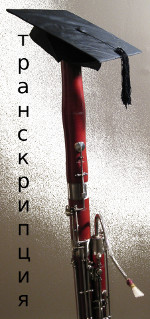TUTORIAL Руководство
1. Welcome to this video on Weissenborn study #33. I am Terry Ewell.
1. Добро пожаловать, это видео о этюде Вайссенборна № 33. Я Терри Юэлл.
2. I play most of the notes on the bassoon with a single fingering, regardless of the dynamics of the note. C#4, however, is an unusual note because I often make use of three fingerings.
2. Я играю большинство нот на фаготе одой аппликатурой, независимо от динамики ноты. До# 4, однако, является необычной нотой, потому что я часто использую три разных аппликатуры.

3. My standard fingering for C#4 is the “French” fingering. I choose this as my regular fingering because it is louder than the “fast” fingering and uses fewer fingers than the “full” fingering. Fewer fingers down allow for quicker movements.
3. Моя стандартная аппликатура для До # 4 - это «французская» аппликатура. Я выбрал ее, потому что она громче, чем «быстрая» аппликатура, и подключает меньше пальцев, чем «полная» аппликатура. Меньше опускающихся пальцев позволяет более быстрых движений.
4. The “fast” or left hand only fingering is used for the faster passages. For many Americans this is their standard fingering.
4. «Быстрая» аппликатура, только в левой руке, используется для более быстрых пассажей. Для многих американцев это стандартная аппликатура.
5. The “full” fingering provides a beautiful tone, and that is one I choose for lyrical and slower passages such as given in this study in the first four lines. I use the other two fingerings later in the study: the French C# when I want more resonance and the fast C# when the passage is difficult. I have not marked any of the C#s as alternate fingerings here so you will need to experiment with what works best for you.
5. «Полная» аппликатура обеспечивает прекрасный звук, и я выбираю его для лирических и более медленных пассажей, таких как в первых четырех строчках этого этюда. Позже в этюде, я использую остальные две аппликатуры: французский До #, когда я хочу больше резонанса, и быстрый До #, когда пассаж очень трудный. Я не отметил ни какой вариант До # как альтернативная аппликатура, поэтому вам нужно будет поэкспериментировать и решить что лучше для вас.
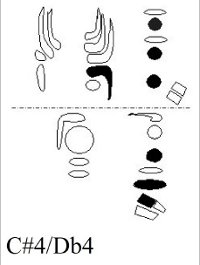
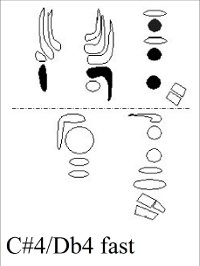
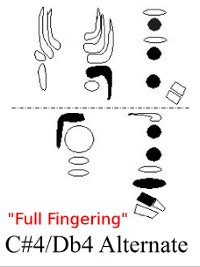
6. I play the turn in line 1 measure 7 with normal fingerings.
6. Я играю пассаж в 7 м такте первой строчке, обычной аппликатурой.
7. However, you might find it easier to use these fingerings as an alternative. In any case, you should remember these fingerings for trills and shakes.
7. Тем не менее, вам может оказаться проще использовать эти аппликатуры в качестве альтернативы. В любом случае, вы должны помнить эти аппликатуры для трелей.
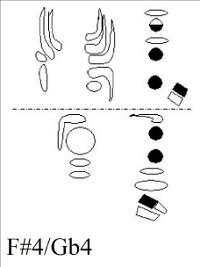
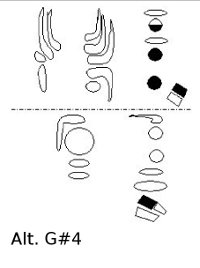
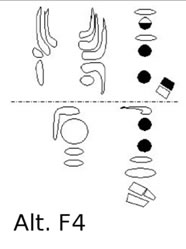
8. The C#-D4 trill in line 2 is fingered like this:
8. Трель До # -Ре4 во 2й строчке играется так:
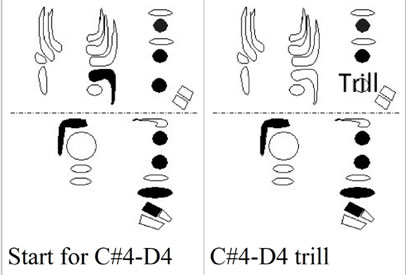
9. Notice that I start with the full C# fingering then release the C# key and raise my left third finger. Then I trill the left third finger.
9. Обратите внимание, что я начинаю с полной аппликатуры До #, затем отпускаю клапан До # и поднимаю левый третий палец. Затем я играю трель левым третьим пальцем.
10. In study #9 I presented reasons for when and where to breathe. Line 3, measure 1 is another interesting case study. I have heard many students make this choice, breathing after B3 on the bar line.
10. В 9м этюде я представил причины, когда и где дышать. Первый такт 3й строчки - еще один интересный пример. Я слышал, что многие студенты берут дыхание после Си3 между тактами.

11. The B3 does sound as if it is a resolution from the F#4. However, this is a musically poor choice! Let me now explain.
11. Си3 звучит так, как будто это разрешение Фа # 4. Тем не менее, это музыкально неудачный выбор! Позвольте мне теперь объяснить.
12. There is an important relationship between line 2, measures 5-8 and the following four measures ending with F#4 in line 3. These two four bar phrases are related. The second four bar phrase is an elaboration, and ornamentation of the first four bars.
12. Между 5м по 8м тактом 2й строчки, и следующими четырьмя тактами, заканчивающимися на Фа # 4 в 3й строчке, существует важная связь. Эти две фразы по 4 такта связанны.Вторая фраза - это разработка и украшение первых четырех тактов.
13. Here are the first two measures of the two phrases.

14. Here are the second two measures of the two phrases.
14. Вот вторые два такта из этих двух фраз.
15. Now, can you hear how they are related? The lower line in the example is an ornamentation or elaboration of the top line. Therefore the breath needs to come in the same place—after F#4. Thus, in line 3, measure 1 the B3 is a pickup to the next phrase.
15. Теперь вы слышите, как они связаны? Нижняя строчка в примере - это орнамент или разработка верхней строчки. Поэтому дыхание нужно брать в том же месте - после Фа # 4. Таким образом, в первом такте 3й строчке, Си3 является затактам к следующей фразе.

16. Weissenborn further indicates this musical understanding by placing the “a” of a tempo immediately over the B3 in line 3, measure 5. He indicates that this B3 belongs as a pickup to the next phrase. You can clearly see the beginning of the phrase at the a tempo is identical to the prior phrase start. This should thus be phrased in the same way.
16. Вейссенборн далее указывает на эту музыкальную идею, помещая слова a tempo над Си3 в пятом такте 3й строчке. Он указывает, что этот Си3 относится к следующей фразе. Вы можете четко увидеть что начало фразы в этом месте, точно такое же как и начало предыдущей фразы. По этому оно должно фразироваться таким же образом.

17. I will not comment on “rf,” the caesuras, and tempos leading up to the fermata since I have discussed these in other videos. You can also observe how I present them in my performance in this video.
17. Я не буду обсуждать «rf», цезуры и темпы, ведущие к фермате, так как я это уже обсудил в других видео. Вы также можете понаблюдать, как я их играю в своем исполнении в конце этого видео.
18. I need to give you fingerings, however, for the mordents and the trill.
18. Однако я должен дать вам аппликатуру для мордентов и трелей.
19. In line 6 the mordent on D4 to E4 is best fingered like this. The addition of the Eb resonance key gives a fuller sound to E4.
19. В 6й строчке лучше всего играть мордент от Ре4 до Ми4, такой аппликатурой. Добавление басового клапана Миb дает более полный звук для Ми4.
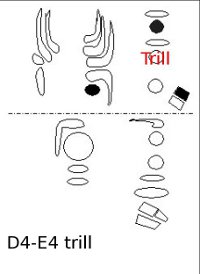
20. В 6й строчке мордент от Си3 до До# 4 - играется стандартной аппликатурой для трели на этих нотах.
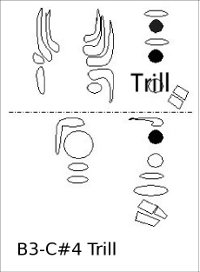
21. In line 10 on the fermata the trill from E4-F#4 is fingered like this:
21. В 10й строчке трель от Си4 до Фа # 4 на фермата, играется так:

22. Last of all, you might need to lightly tongue the slur to A#2 in line 4. If you choose to do this, don’t tongue the center of the reed, rather tongue a corner of the reed. This will make the articulation less noticeable and still help the note to respond. Tonguing the corner of the reed yields a more legato articulation than tonguing in the center of the reed.
22. И наконец, вам, возможно, придется слегка артикулировать лигу в Ля#2 в 4й строчке. Если вы решите это сделать, не ведите язык в центр трости, а в угол. Таким обозом артикуляция будет менее заметной и все же поможет ноте лучше среагировать. Язык в углу трости дает артикуляцию более легато, чем в центре трости.
23. I assume that you are correctly flicking the articulated notes for A3, B3, Bb3, and C4. All your notes need to start cleanly. In line 12, the downward slur from E4 to A3 comes out best by flicking the A key. If you need to review flick keys please see studies 3 and 4.
23. Я предполагаю, что вы правильно щелкаете клапанами для артикулированных нот Ля3, Си3, Сиb3 и До4. Все ваши ноты должны начинаться чисто. В 12й строчке нисходящая лига от Ми4 до Ля3 получается лучше всего, если щелкнуть по клапану Ля. Если вам нужно просмотреть этот вид техники, посмотрите видео этюдов номер 3 и 4.

REFLECTION Размышление
24. A man who has friends must himself be friendly. (NKJV, Prov. 18:24)
24. Кто хочет иметь друзей, тот и сам должен быть дружелюбным (Притчи 18:24)
25. The importance of making friends should not be underestimated in the music industry. It is often people who know you who recommend you for jobs. During the interview process for the first university where I was hired there was a person on the search committee who knew me from our days in a youth orchestra. His advocacy was important for me getting the chance to interview for the job. This was the job that started my full-time academic career.
25. В музыкальной индустрии нельзя недооценивать важность дружбы. Часто люди, которые знают вас, рекомендуют вас на работу. На интервью в первом университете, где меня наняли, был человек, который знал меня с наших дней в молодежном оркестре. Его дружба была важна, чтобы я получил возможность достать интервью для этой работы. Именно с этой работы началась моя академическая карьера.
26. It is usually the case that when you interview or audition for a bassoon position in the USA, your committee will be comprised of non-bassoonists. For instance, when a university replaces a bassoon professor position, that bassoon teacher is not on the committee. The committee may contain other woodwind teachers, or performers, or professors or staff from other fields. Remember that your friendships should go out to people who perform different instruments or do other things in music. Be friendly to many people, not just those who play the bassoon.
